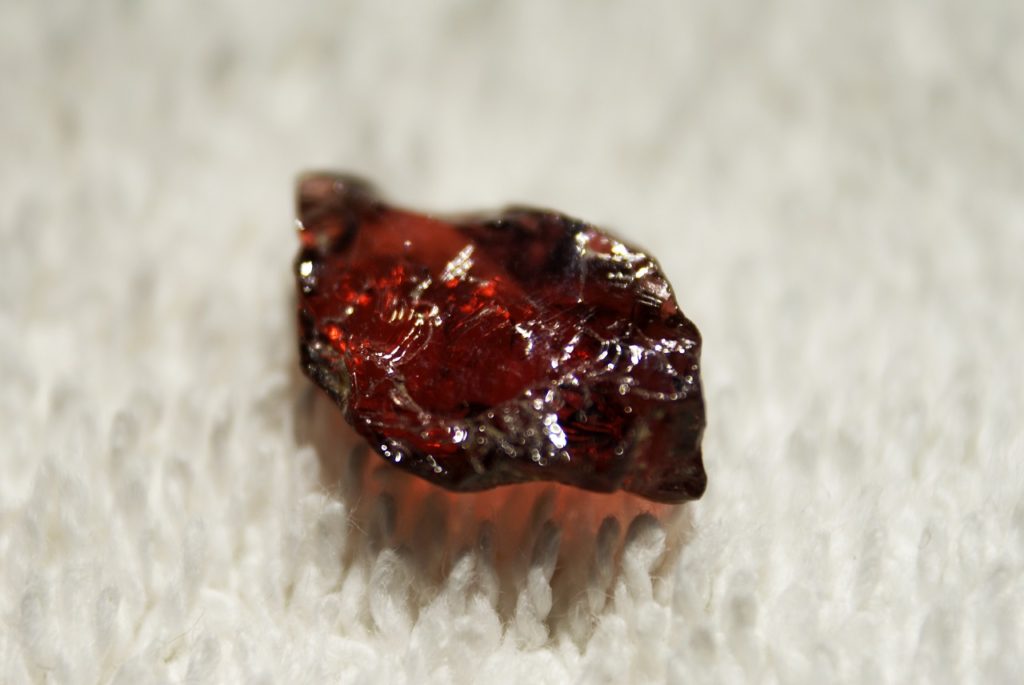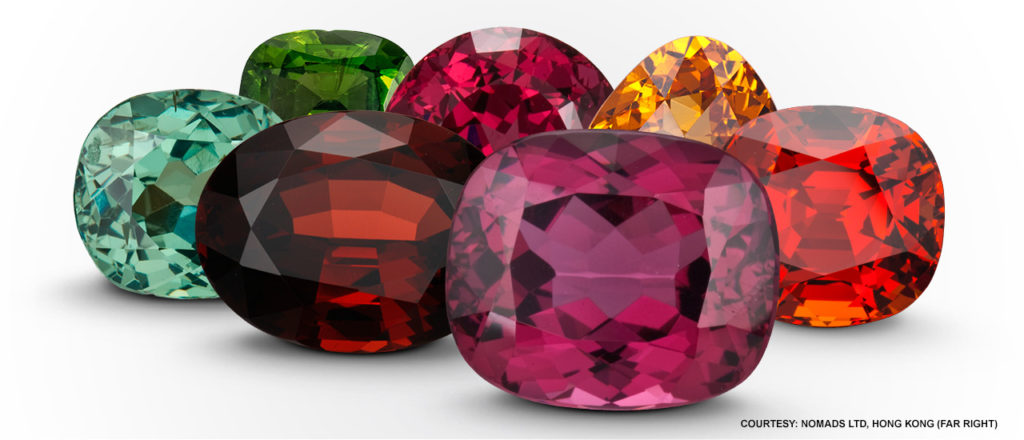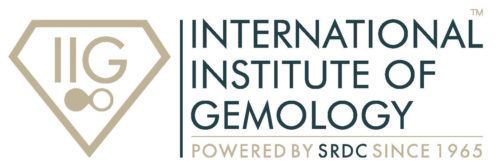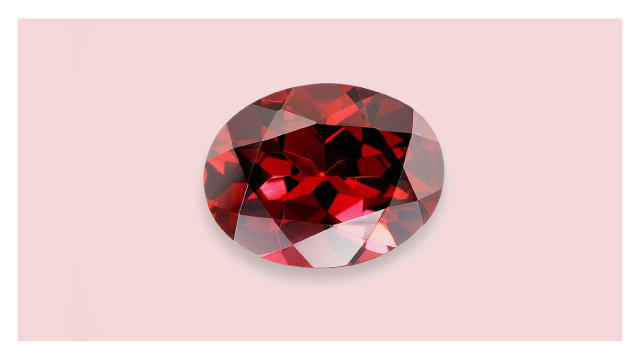|
Getting your Trinity Audio player ready...
|
History of Garnet
Red garnets were the most popular gemstone in the later years of the Roman Empire. The name “garnet” originates from the medieval Latin granatus, meaning “pomegranate,” in reference to the similarity of the red color. Another characteristic of garnets is their high refractive index which gives onlookers the impression that the gem is emitting light.
This phenomenon led explorers and travelers to carry garnets with them on their journeys to ward off evil and light up the night. This practice persisted through the Crusades. Interestingly, garnets’ association with protection was made in other ancient cultures as diverse as the Aztecs in Central America and some Eastern Asiatic tribes whose warriors would carry them into battle. Some of these tribes would even attempt to turn the tables on their enemies who were using garnets for protection by fashioning arrowheads (and eventually bullets during the late 1800s) out of garnets. While we don’t recommend that use for garnets, we do think the gift of garnet is a great way to let a loved one know you want them to be safe on all of their future journeys.
Garnet is a popular gemstone that belongs to the group of silicate minerals. It is generally oval or pear-shaped and wine red in color. There are different species of Garnet being used worldwide that possess the same crystal form and physical properties but each has its own unique chemical composition. Garnet is traditionally a birthstone for those born in the month of January.
Garnet is actually a group of several minerals – Pyrope (Red), Almandine (Purple), Spessartine (Orange & Yellow), Grossular (widest range, from colorless through yellow to reddish-orange and orangy-red), andradite (mostly yellow to green) and Tsavorite (Green) – are some of the important garnet varieties.

Where is Garnet Found?
Bohemia was the primary source of the red pyrope garnets so popular during Victorian times. In the 19th century Russia, green demantoid garnets from the Ural Mountains were prized by the Russian royal family and used by the great jeweler Peter Carl Fabergé (1846–1920). Today, the African continent supplies much of the world’s garnet. Demantoid garnets were first discovered in Russia’s Ural Mountains in 1868. Until 1919, at the start of communist Russia, demantoids were widely used and became popularized by Peter Carl Faberge’s jewelry. There are now deposits in Namibia, and in 2009, a deposit was found in Madagascar. Tsavorite garnet was first discovered in Tanzania in 1967 by Charles Bridges. Tiffany & Co. marketed the gemstone in the early 70s to the public. Since its popularization, Tsavorites have been extremely valuable and difficult to find in large sizes.

Garnet Varieties
There are many varieties of garnets, but not all of them are used for jewelry production. Gem-quality garnets are broken into six main types:
- Almandine – the most common type of garnet that is usually dark red to reddish-brown.
- Pyrope – the most well-known variety that comes in deep red color and can rival rubies.
- Spessartite – at its best this type of garnet has a bright orange color and unique brilliance that makes it a highly sought-after gemstone.
- Grossular – in its purest form this type is colorless; however, impurities can turn it into many beautiful colors and shades including the rare and very valuable green Tsavorite.
- Andradite – the most sparkly variety that comes in many colors commonly in green and black. However, the term Andradite is not often used to describe gems. This type is usually broken down into further groups, including highly valued Demantoid garnets.
- Uvarovite – a unique garnet type that appears only in green color, usually in small crystals.
These six varieties are formally recognized names for the garnet, but they are further divided into groups depending on their trade names, colors, and sources. Some garnets can also be a blend of two or more species. For example, Rhodolite garnet is a blend of pyrope and almandine. Malaya, also known as Imperial Garnet, is a blend of pyrope and spessartite.
There are also Star Garnets that have brownish-red or reddish-black coloring and display 4-rayed or even 6-rayed stars. This phenomenon is caused by rutile needle inclusions that align in a specific way to reflect light in a star-shaped pattern.
Clarity of Garnets?
Typical garnet clarity depends on the garnet type. For example, the red garnets almandine, pyrope, and rhodolite typically do not have eye-visible inclusions. Some of the orange garnets, like spessartine and hessonite, often have eye-visible inclusions. Hessonite garnet often has a turbulent inner appearance called the roiled effect. Demantoid garnet might have eye-visible inclusions called horsetails that can raise its value.
Hardness
Garnet is a relatively durable gemstone, 6.5 – 7.5 on the Mohs hardness scale. It is hard enough to survive accidental hits; however, you should take special care to prevent damages.
GARNET PROPERTIES
| Category | Nesosilicate |
| Chemical Name | Silicate |
| Chemical Formula | Almandine – Fe3Al2(SiO4)3
Pyrope – Mg3Al2(SiO4)3 Spessartite – Mn3Al2(SiO4)3 Grossular – Ca3Al2(SiO4)3 Andradite – Ca3Fe2(SiO4)3 Uvarovite – Ca3Cr2(SiO4)3 |
| Crystal System | Isometric |
| Colors | Typically red, but can be orange, green, yellow, purple, black, or brown. |
| Hardness | 6.5 – 7.5 on the Mohs scale |
| Refractive Index | 1.72 – 1.94 |
| Specific Gravity | 3.5 – 4.3 |
| Transparency | Transparent to translucent |
| Birefringence | None |
| Lustre | Vitreous to resinous |
| Cleavage | None |
| Streak | White |
| Fluorescence | Variable |

Influence of Garnet on People:
- Garnet is a lucky stone that brings love and success in people’s life.
- It possesses an energy that ensures success in business ventures and relationships. It is also referred as the ‘travellers’ stone’.
- Ushers in wealth, fame, and prosperity
- It helps in curing several body ailments and psychological illness.
- Garnet is effective in dealing with hostile forces and reduces enmity and tension caused by the same.
Healing Powers of Garnet:
- Garnet possesses medicinal abilities that help in reducing body toxins. It stimulates metabolism and helps in treating cellular and spinal disorders.
- It also regenerates DNA and helps in the purification of blood, lungs, and heart.
- The use of Garnet also offers a protective influence and calming stability. Its use has shown to heal emotional problems.
- Garnet gemstone is used to treat a depressed state of mind and alleviate bad dreams. The healing energy in Garnet helps to maintain a balance in the energy system which in turn uplifts attitude and stimulates desires.
- Protects against disease and poisonous bites.
IN SHORT:
What’s January’s Birthstone – Garnet
What’s the meaning of garnets? – Protection
Color: Dark Red

